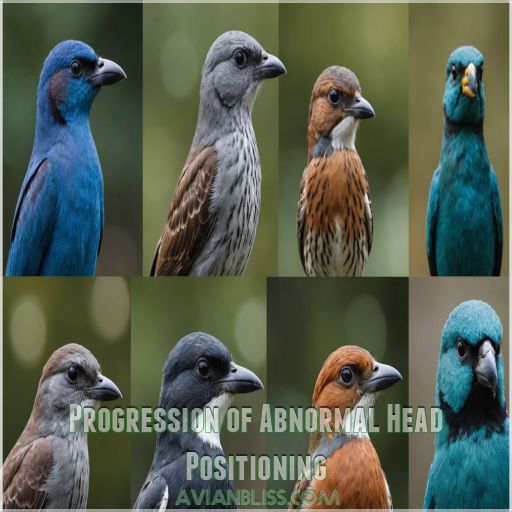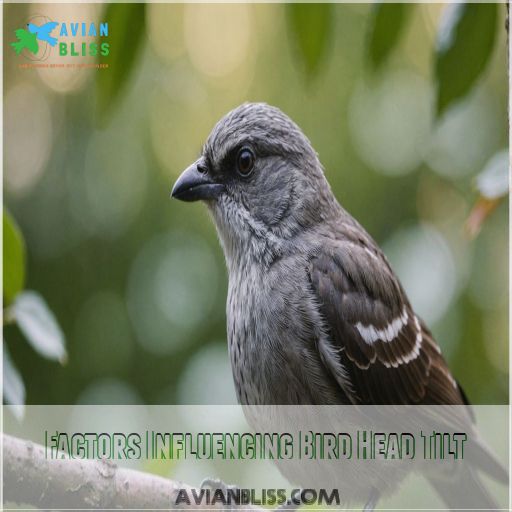This site is supported by our readers. We may earn a commission, at no cost to you, if you purchase through links.

Trying to get a better look at something (who hasn’t tilted their head to hear a juicy bit of gossip?) is a possible explanation, but it could also signal an ear infection or even balance issues like inner-ear problems.
Other culprits include viral infections, metal poisoning, or nutritional deficiencies. Pay attention to other signs like stance changes or loss of balance.
Consulting with a vet is key to sorting things out. Curious about those quirky head tilts? Stick around to learn more.
Table Of Contents
- Key Takeaways
- Causes of Bird Head Tilt
- Progression of Abnormal Head Positioning
- Treatment Options for Head Tilt
- Why Birds Tilt Their Heads
- Factors Influencing Bird Head Tilt
- Importance of Understanding Bird Body Language
- Frequently Asked Questions (FAQs)
- Why do birds tilt their head sideways?
- Do birds tilt their heads when they sleep?
- Why does my Budgie tilt his head sideways?
- What causes a bird to roll its head from one side?
- What does it mean when a bird tilts its head sideways?
- What does it mean when a bird moves its head side to side?
- How do you treat a bird’s twisting head?
- What does ataxia look like in birds?
- How does head tilt affect bird behavior?
- Can head tilt be a sign of stress?
- What environmental changes help correct head tilt?
- Are there specific breeds prone to head tilt?
- How do head tilts impact social interactions among birds?
- Conclusion
Key Takeaways
- When your feathered friend starts tilting its head, it could be a sign of health issues, such as infections, inner-ear problems, or heavy metal poisoning. Keep an eye out for other symptoms, like balance troubles or feeding difficulties.
- Consulting an avian vet is crucial to get an accurate diagnosis and a customized treatment plan. Don’t wing it – trust the experts to get your bird back on track.
- Believe it or not, that quirky head tilt is actually a clever adaptation. Birds use it to improve their vision, balance, and foraging abilities; it’s like their own built-in camera lens.
- The type of bird, its environment, and its overall health can all influence how and why it tilts its head. Pay attention to changes in behavior – it could reveal deeper issues you’ll want to address.
Causes of Bird Head Tilt
When your bird starts tilting its head sideways, it’s usually more than just quirks in their vision.
It could be a sign of health issues like infections or heavy metal poisoning.
Sometimes it’s an inner-ear problem, which wouldn’t be surprising given how birds manage to stay balanced on the skinniest of branches.
Viral or Bacterial Infections
Oftentimes, a bird’s head tilt can be caused by viral or bacterial infections. These pesky bugs can wreak havoc on your feathered friend’s balance and equilibrium.
To get your bird back on track, look for these signs:
- Tremors or convulsive movements
- Unusual head positions
- Opisthotonos (neurological disease)
- Respiratory distress like sneezing or coughing
With the right treatment protocol, your bird can make a full recovery.
Inner-Ear Problems
Imagine your bird tilting its head like it’s trying out for a role in a mystery movie. This tilt often hints at inner-ear problems like infections or vestibular disease, affecting balance and causing head tremors. Just like a dizzy spell after a roller coaster, these issues mess with bird balance and perception.
| Problem | Effect on Balance | Treatment Protocols |
|---|---|---|
| Inner-ear infections | Severe imbalance | Antibiotics, rest |
| Vestibular disease | Head tremors | Supportive care |
| Inflammation | Balance issues | Anti-inflammatory meds |
Heavy Metal Poisoning
When your feathered friend tilts its head, you might worry.
While inner-ear issues could be the culprit, heavy metal poisoning from sources like galvanized cages can also affect a bird’s balance.
Symptoms include unsteady movements and seizures.
To support your bird, focus on treatment protocols and prevention strategies.
Consider safer bird environments to keep curious beaks from harmful metals.
Progression of Abnormal Head Positioning
You might notice your bird’s head tilt starting as a quirky habit, but it can quickly become a serious issue affecting its balance and ability to eat or fly.
If left unchecked, those cute head tilts can lead to significant troubles, leaving your feathered friend struggling to find food and water or even unable to take off into flight.
Early Warning Signs
You know your bird’s got something up its sleeve when it starts showing early warning signs like a twisted neck or changes in its stance.
Keep an eye out for loss of appetite, lethargy, or even a peculiar owl head tilt, which could be a sign of a vitamin E deficiency.
Additionally, head and neck injuries or infections can also cause abnormal head positioning.
Abnormal gait and feather plucking join the party, along with discharge from eyes or nose—clear signals it’s vet time!
Loss of Balance and Coordination
Ever seen a bird wobbly as a jelly? Loss of balance and coordination can make your feathered friend’s head tilt go haywire.
To help:
- Try Physical Therapy and Avian Exercises.
- Engage in Balance Training.
- Explore Home Remedies for gentle relief.
- Make sure you prevent Falls by securing the environment.
A stable perch is worth its weight in feathers!
Difficulty Finding Food and Water
Losing balance might soon complicate a bird’s quest for food and water.
Picture trying to eat spaghetti while on a merry-go-round—an odd combination, right? Birds with head tilts face similar scenarios.
Their confused orientation leads to feeding difficulties, and they might even fumble when reaching water sources.
Consider enhancing cage setup to simplify access and meet their nutritional needs and help with feeding difficulties.
Inability to Fly
If your feathered friend can’t take to the skies, it could be due to wing injuries, muscle weakness, or even nutritional deficiencies.
Check for any missing feathers or abnormal wing positioning.
Make sure they’re getting a balanced diet and consider consulting an avian vet if the issue persists.
With a little TLC, they’ll be soaring again in no time!
Treatment Options for Head Tilt
If your bird’s head is tilted, a mix of medications like Nystatin or Trimethoprim Sulfa, along with Vitamin B12 and improved diet, could help.
Always check with your avian vet first—after all, you wouldn’t want your parrot self-prescribing from a bird health blog!
Nystatin and Trimethoprim Sulfa
Imagine this: your bird tilts its head, resembling a perplexed emoji.
Nystatin and Trimethoprim Sulfa can be your trusty sidekicks! They battle fungal and bacterial infections causing head tilts.
Get the dosage right for effectiveness, but watch for side effects.
Consider alternatives and research thoroughly. Always ask your bird’s vet before leaping to conclusions.
Your feathered friend’s health comes first!
Vitamin B12 and Enhanced Nutrition
Through enhancing your bird’s diet, you can tackle that quirky head tilt.
Vitamin B12 deficiency might cause this issue, but luckily, nutritional supplements and a balanced diet can help restore your bird’s health.
Avian nutrition holds the key to a sprightly bird with a balanced iodine rich diet
.
So, why not spruce up their diet with some vitamin-rich treats? It’s worth a shot!
Importance of Consultation With Avian Veterinarian
You’ve bolstered your bird’s health with Vitamin B12; now, consult an avian vet for expert treatment.
Their skills bring accuracy, drawing up plans specifically for your feathered friend.
Note the benefits of consultation:
- Diagnosis Accuracy
- Customized Treatment Plans
- Prognosis & Prevention
- Bird Owner Education
Don’t wing it—trust a vet’s expertise!
Role of UV Light in Preventing Vitamin D Deficiency
While chatting with your avian vet about head tilt, consider UV light‘s role in bird health.
Indoor birds, much like living room dancers, need sunlight exposure or UV light sources to beat Vitamin D deficiency. This helps keep their bones strong and their balance steady.
Just like nocturnal birds with large eyes, such as rock kestrels with superb vision, indoor birds need the right amount of light to thrive. Imagine birds flaunting healthy feathers without missing a beat!
| Day | UV Exposure | Bird’s Mood |
|---|---|---|
| 1 | None | Grumpy |
| 2 | 15 mins | Perky |
| 3 | 30 mins | Jubilant |
| 4 | 45 mins | Euphoric |
| 5 | 1 hour | Blissful |
Why Birds Tilt Their Heads
Have you ever noticed a bird tilting its head sideways and wondered why it’s doing that?
Birds do this neat little trick to improve their vision and balance, helping them spot food or stay steady on a windy branch.
Improved Vision and Perception
Ah, the head tilt – it’s not just a quirky bird habit, but a clever adaptation!
By tilting their heads, birds can improve their depth perception and visual acuity, making it easier to spot prey or navigate their surroundings. This monocular vision allows them to focus on specific targets, almost like a built-in camera lens.
So next time you see a bird with a tilted head, give them a nod of appreciation for their ingenious design.
Better Balance and Stability
Spotting a bird with its head tilted feels like watching a balance act. This quirky posture enhances perch stability and helps maintain avian balance against gravity’s sway (Source). You’ll notice their foot grip strengthens, keeping them stable.
- Marvel as they sway with grace.
- Smile as they conquer gravity.
- Admire their dance of stability.
Assisting With Foraging
You’ve admired birds balancing flawlessly. Now, consider their quirky head tilt while foraging. They’re not just striking a pose—they’re perfecting their prey detection and hunting techniques.
By angling their heads, birds like robins can spot worms more easily, despite having side-placed eyes (Source).
| Attribute | Bird Action |
|---|---|
| Food Preferences | Focused observation |
| Beak Adaptation | Visual acuity adjustment |
| Foraging Strategies | Head tilt optimization |
| Prey Detection | Enhanced vision |
| Hunting Techniques | Precise targeting |
Factors Influencing Head Tilt
When you’re watching birds forage, you’ll notice head tilts vary across species.
Influenced by their surroundings, age, and health, these variations can be observed in different scenarios. Picture a robin tilting to spot a worm with sharper vision, or a parrot doing the same for fun.
Different environments impact these variations—city streets or quiet forests set the scene and frequency of these intriguing tilts.
Factors Influencing Bird Head Tilt
When your feathered friend tilts its head sideways, it could be checking out its world or signaling an issue.
Factors like the bird’s type, environment, and health can all shape this curious tilt.
Making it essential to watch for changes in behavior.
Type of Bird and Unique Adaptations
Consider how different bird species, such as small birds with red heads, showcase unique head tilts like Northern Cardinals
.
Owls, nature’s secret predators, tilt their heads to spot prey. Parrots exhibit head tilts often in playful mimicry or curiosity. Finches adapt their tilt for foraging ease, while hummingbirds demonstrate agility in flight with quick head movements.
Some birds also use head-bobbing to stabilize their vision and track fast-moving objects, much like head-bobbing techniques used by raptors to pinpoint prey.
Each behavior reflects specialized adaptations enhancing survival and interaction.
Surroundings and Environment
Exploring why birds tilt their heads, you’ll want to think about their surroundings, like cage size and noise levels. A cramped cage feels like wearing a too-tight hat, and loud noises can make birds spin like ballerinas with jazz hands.
| Factor | Impact on Bird |
|---|---|
| Cage Size | Stress Levels |
| Habitat Enrichment | Mental Stimulation |
| Noise Levels | Anxiety |
| Temperature | Comfort |
| Lighting | Sleep Patterns |
Keep their environment balanced!
Health and Age of the Bird
As your feathered friend ages, their health can impact their head tilt.
Vitamin E deficiencies or infections may cause muscle weakness and neurological issues.
Keep an eye on their diet and droppings, and consult an avian vet if you notice:
- Difficulty balancing or flying
- Lethargy or loss of appetite
- Changes in feather condition
- Unusual head positioning
Examples of Head Tilt in Different Species
In owls, head tilting can look dramatic, almost like they’re saying, “Wait, what?"
Parrots might tilt their heads while preening or bonding, much like humans nodding in agreement.
Finches and pigeons do this to gain different perspectives on their surroundings, while chickens tilt to spot food or danger, making each species’ tilt a unique avian adaptation.
Importance of Understanding Bird Body Language
Understanding bird body language lets you notice when they’re relaxed or in distress, much like knowing when your friend’s joking or venting.
It’s a skill that deepens your appreciation for birds while helping protect their safety and well-being.
Better Observation Skills
Developing Sherlock Holmes-level bird observation skills is important for understanding bird behavior, making you feel like a bird-watching detective.
- Identify Species: Knowing bird species like they’re old friends helps make sure you provide proper bird care.
- Detect Health Issues: Spotting unusual bird behavior, such as a bird tilting its head sideways, can be a sign of common bird diseases symptoms like avian pox or salmonellosis, which can be identified by observing common bird diseases symptoms. Spotting unusual bird behavior can reveal bird health problems early on.
- Enhance Bird Watching: Observing body language turns bird watching into an adventurous, real-life documentary.
So, grab those binoculars and start bird whispering! After all, who doesn’t love a good mystery with feathers?
Identifying Signs of Distress or Threat
Imagine this: your bird’s feathers ruffled like it just heard a juicy gossip, its wings drooping like it’s had a taxing day, and those eyes changing more rapidly than a traffic light.
Pay attention, for these could signal distress or threat in bird behavior. Vocalization changes—imagine going from a soothing melody to a heavy metal scream—are also clues.
Understanding these signs empowers you to act swiftly and keep your feathered friend chirpily content by recognizing the signs of trust
. After all, nobody wants a grumpy avian companion!
Frequently Asked Questions (FAQs)
Why do birds tilt their head sideways?
Clever critters, those birds! They tilt their heads to focus their singular vision, honing in on their tasty treats with laser-like precision.
This monocular marvel allows them to spot even the sneakiest of snacks.
Do birds tilt their heads when they sleep?
Birds don’t tilt their heads while sleeping the way we do.
Instead, they often tuck their heads backward into their feathers for warmth and protection.
This cozy position might resemble a twisted neck but is quite normal .
Why does my Budgie tilt his head sideways?
Rolling back to the typewriter days, your budgie tilts its head likely due to a stroke or viral infection.
Consider visiting an avian vet to get a solid diagnosis.
It’s all about getting your feathered buddy back on track.
What causes a bird to roll its head from one side?
A bird might roll its head due to curiosity, exploring its surroundings, or even a playful mood.
Sometimes it seeks attention or feels disoriented due to health issues like ear infections.
Keep an eye for other symptoms.
What does it mean when a bird tilts its head sideways?
Imagine Sherlock scanning clues—
Birds tilt their heads to focus on a target, using one eye for better detail.
This helps them locate food like worms or grubs efficiently, thanks to their unique monocular vision.
What does it mean when a bird moves its head side to side?
When a bird moves its head side to side, it’s likely scanning its environment for potential threats or interesting sights.
This behavior aids in depth perception by giving the bird a better view of its surroundings.
How do you treat a bird’s twisting head?
Treat a bird’s twisting head like fixing an 8-track player.
Start by consulting a vet.
Boost vitamin E in its diet, and check for injuries or infections.
Offer a cozy habitat with easy access to food and water.
What does ataxia look like in birds?
Ataxic birds appear wobbly, with legs spread wide to balance.
They may stumble, fall off perches, and have trouble coordinating movements.
This loss of muscle control signals serious underlying issues requiring prompt veterinary care.
How does head tilt affect bird behavior?
Picture a bird’s head tilt like a compass needle gone awry; it signals possible neurological issues.
Birds may struggle with balance, feeding, or social cues, often leading to a withdrawn demeanor [15].
Can head tilt be a sign of stress?
Yes, a head tilt can be a sign of stress in birds.
They might be feeling out of whack due to new surroundings or situations, which can lead to unusual behaviors like head tilting or other stress indicators.
What environmental changes help correct head tilt?
Think of your bird’s head tilt as a compass needle searching for balance.
Tweak its environment by reducing stress, ensuring a quiet space, and maintaining a consistent light-dark cycle.
This adjustment can help your feathered friend regain equilibrium (Source).
Are there specific breeds prone to head tilt?
Certain dog breeds, like German Shepherds and Doberman Pinschers, are more prone to head tilt.
This condition affects balance and appears more frequently in older dogs but can also occur in younger ones due to vestibular disease .
How do head tilts impact social interactions among birds?
Birds tilting their heads, like detectives pondering life’s mysteries, affects social dynamics by showing curiosity and attention.
This quirky behavior helps them evaluate sounds and surroundings, fostering effective communication and strengthening group interactions.
This behavior also fosters the strengthening of bonds among flocks , due to the display of curiosity and attention through the tilting of their heads, revealing an overall impact on social dynamics.
Conclusion
Ever wonder why a bird tilting its head sideways grabs your attention? It’s more than curiosity—it could point to issues like infections or balance problems.
Watching for other signs, like balance issues or trouble flying, is really important. Consulting a vet helps you pinpoint the cause and get effective treatment.
Remember, while head tilts can be cute, they might signal deeper issues requiring attention. Keep a watchful eye, and your feathered friend will thank you for taking the time to treat the underlying cause of the balance problems.









